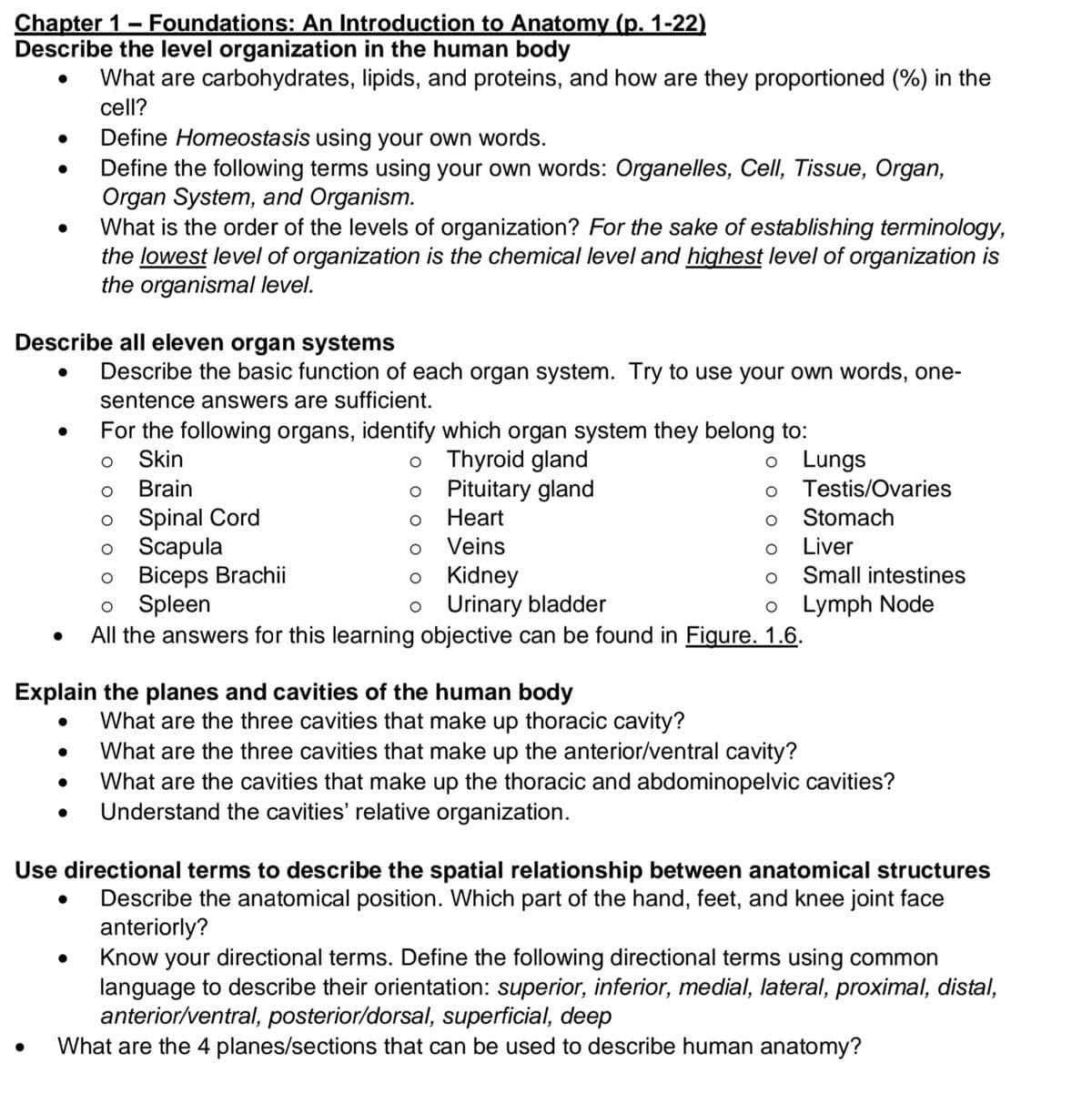Describe the level organization in the human body What are carbohydrates, lipids, and proteins, and how are they proportioned (%) in the cell? Define Homeostasis using your own words. Define the following terms using your own words: Organelles, Cell, Tissue, Organ, Organ System, and Organism.
Describe the level organization in the human body What are carbohydrates, lipids, and proteins, and how are they proportioned (%) in the cell? Define Homeostasis using your own words. Define the following terms using your own words: Organelles, Cell, Tissue, Organ, Organ System, and Organism.
Human Physiology: From Cells to Systems (MindTap Course List)
9th Edition
ISBN:9781285866932
Author:Lauralee Sherwood
Publisher:Lauralee Sherwood
Chapter1: Introduction To Physiology And Homeostasis
Section1.3: Concept Of Homeostasis
Problem 3CYU
Related questions
Question
I need help with this study guide Is very complex but hard to find the right answers for this.

Transcribed Image Text:Chapter 1- Foundations: An Introduction to Anatomy (p. 1-22)
Describe the level organization in the human body
What are carbohydrates, lipids, and proteins, and how are they proportioned (%) in the
cell?
Define Homeostasis using your own words.
Define the following terms using your own words: Organelles, Cell, Tissue, Organ,
Organ System, and Organism.
What is the order of the levels of organization? For the sake of establishing terminology,
the lowest level of organization is the chemical level and highest level of organization is
the organismal level.
Describe all eleven organ systems
Describe the basic function of each organ system. Try to use your own words, one-
sentence answers are sufficient.
For the following organs, identify which organ system they belong to:
o Thyroid gland
Pituitary gland
Skin
o Lungs
Brain
Testis/Ovaries
Spinal Cord
Scapula
Biceps Brachii
Spleen
All the answers for this learning objective can be found in Figure. 1.6.
Heart
Stomach
Veins
Liver
Small intestines
Kidney
o Urinary bladder
o Lymph Node
Explain the planes and cavities of the human body
What are the three cavities that make up thoracic cavity?
What are the three cavities that make up the anterior/ventral cavity?
What are the cavities that make up the thoracic and abdominopelvic cavities?
Understand the cavities' relative organization.
Use directional terms to describe the spatial relationship between anatomical structures
Describe the anatomical position. Which part of the hand, feet, and knee joint face
anteriorly?
Know your directional terms. Define the following directional terms using common
language to describe their orientation: superior, inferior, medial, lateral, proximal, distal,
anterior/ventral, posterior/dorsal, superficial, deep
What are the 4 planes/sections that can be used to describe human anatomy?
Expert Solution
This question has been solved!
Explore an expertly crafted, step-by-step solution for a thorough understanding of key concepts.
Step by step
Solved in 2 steps

Knowledge Booster
Learn more about
Need a deep-dive on the concept behind this application? Look no further. Learn more about this topic, biology and related others by exploring similar questions and additional content below.Recommended textbooks for you

Human Physiology: From Cells to Systems (MindTap …
Biology
ISBN:
9781285866932
Author:
Lauralee Sherwood
Publisher:
Cengage Learning

Anatomy & Physiology
Biology
ISBN:
9781938168130
Author:
Kelly A. Young, James A. Wise, Peter DeSaix, Dean H. Kruse, Brandon Poe, Eddie Johnson, Jody E. Johnson, Oksana Korol, J. Gordon Betts, Mark Womble
Publisher:
OpenStax College

Human Physiology: From Cells to Systems (MindTap …
Biology
ISBN:
9781285866932
Author:
Lauralee Sherwood
Publisher:
Cengage Learning

Anatomy & Physiology
Biology
ISBN:
9781938168130
Author:
Kelly A. Young, James A. Wise, Peter DeSaix, Dean H. Kruse, Brandon Poe, Eddie Johnson, Jody E. Johnson, Oksana Korol, J. Gordon Betts, Mark Womble
Publisher:
OpenStax College